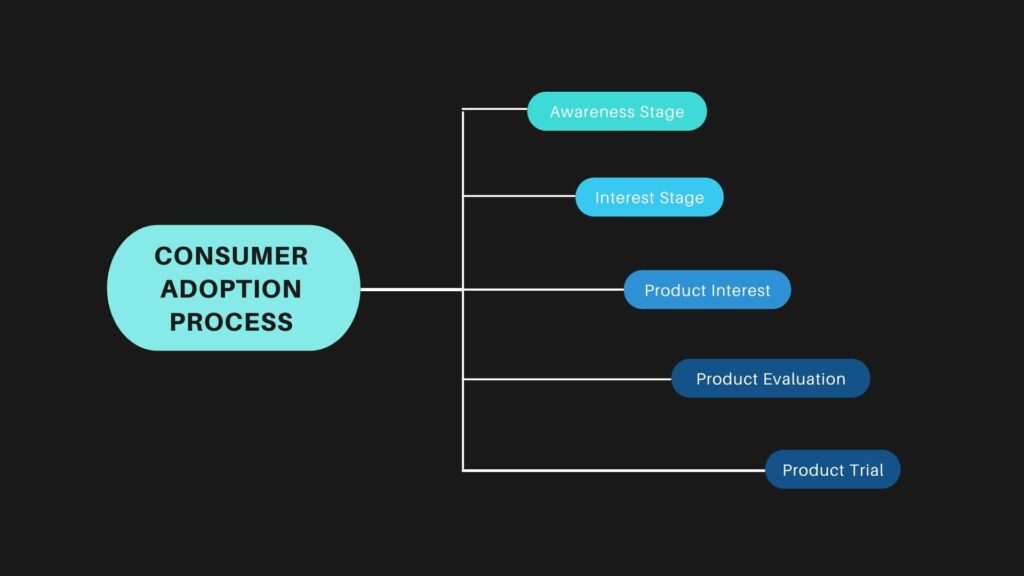What is the consumer adoption process?
Consumer adoption is the process by which consumers change their buying and usage patterns in response to a new product or service. To answer this question, we need to understand what consumer adoption is and then what are the steps involved in it. Simply put: Consumer adoption is when a company launches a new product or service as an alternative to existing products and people start using it as soon as it’s launched.
What are the 5 stages of the adoption process?
The 5 stages of the adoption process are Product Awareness, Product Interest, Product Evaluation, Product Trial, and Product Adoption.

Awareness Stage
The product awareness stage is the first step in the consumer adoption process. It refers to the period when a potential customer becomes aware of your product or service and starts to consider its purchase. At the moment he becomes aware of your product, an unengaged customer is more likely to become interested and buy vs. someone who’s already engaged in a buying process. Some factors that contribute to the awareness stage are:
- The degree of awareness that your company has about your product/service, which can be achieved through advertisements, social media posts, press releases, etc.
- How well-known your company is in the market.
- The type of positioning you have for your brand/product/service – whether it’s positioned as an “always-on” brand or one that’s more lifestyle-oriented.
During this stage, marketers focus on gaining attention from their target audience through advertising and marketing activities such as television commercials, radio spots, newspaper ads, billboards, email, the internet, etc. One of the most effective ways to reach consumers in this stage is through influencers who are already aware of the product or service. These individuals can talk about your brand on social media platforms like Instagram, Facebook, and Twitter and start getting their followers interested in your brand too.
Interest Stage
In this stage, the consumers seek information about the new product. But how do they do it? To answer this question, we need to understand the various channels through which people seek information about a new product. They could be:
- Directly asking the company or their representatives for more information.
- Searching online for reviews and ratings of the product.
- Using social media channels like Facebook and Twitter to find out more about it.
- Searching on Google, Bing, Yahoo, or any other search engine that they know of.
Through the channels that mention your product/service, consumers can engage with it. For example, if they search for “laptops”, users may find out about you by looking at results like “Review of ASUS Chromebook C100 closer to my budget”.
Evaluation Stage
In the evaluation stage of the buying process, consumers are looking for a product that meets their needs and fits within their budget. Before purchasing a product, they will look at the different options available in the market to compare prices and features. They will also check out reviews on social media or websites to get an idea of what other people think about it.
The consumer will consider their budget, needs, wants, and how much they are willing to spend before deciding whether or not they want to purchase a product. For example, in case you are selling a laptop that is different from your competitors. Your social media posts could include the following: “Thinking about buying an ASUS Chromebook C100?” which would get people talking to their friends and asking for tips on whether or not they should buy it.
Trial Stage
This is the phase where consumers use the product for a period of time to determine if it will meet their needs. This is when they decide whether or not they will purchase it. They may use the product for a few days, weeks, months, or years depending on how long they need to try out different features and functions of your product. Once people have used your product for a period of time, they are more likely to purchase it because they know what to expect from it and that there are no hidden surprises waiting for them in this stage.
Marketers can induce change in consumer behavior by offering them free samples of the product. In order to understand the significance of this stage, let’s consider some key points:
- The majority of products that are sold today were first introduced as a trial before becoming mainstream.
- This allows companies to gain insight into what features and benefits consumers find most appealing.
- The more trials a company has, the more data they have on how customers actually use their products and what they like/dislike about them.
Adoption Stage
In order to understand the importance of the adoption stage, let us first understand what consumer adoption is. Consumer adoption is defined as “the process by which people change their behavior in response to changes in external conditions.” A product that has reached the final phase of its life cycle is one that has been purchased by consumers. This means that it’s being used by them for whatever purpose they have purchased it for, whether it be personal use or business use.
It also defines how much they are willing to pay for your product, which can lead to further revenue opportunities if you’re selling products through different channels like online stores and brick-and-mortar stores. In order for a product to stay relevant and continuously be in the “used by” category, it must have continued usage. The longer a product is being used but not purchased or sold can lead to brand interest waning in that particular market/industry with no one making purchases of the same item.
Conclusion
Marketers can influence the various stages of the consumer adoption process through marketing strategies such as adjusting the marketing mix. The key is to understand the 5 adopter groups according to the diffusion of innovation theory. The five types of adopter categories according to the theory are innovators, early adopters, early majority, late majority, and laggards. You can read more about it from our diffusion of innovation theory blog.
